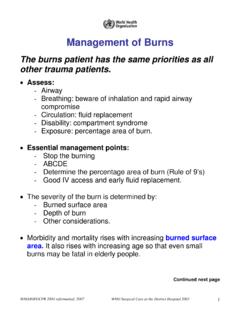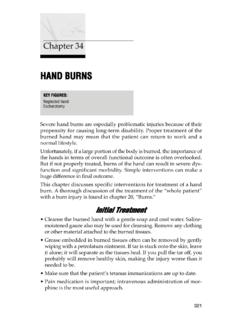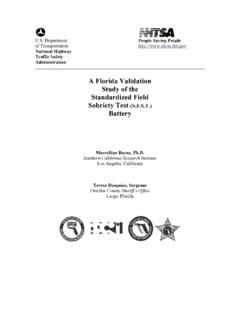Transcription of Multivariate GARCH with Only Univariate Estimation
1 Multivariate GARCH with only Univariate Estimation Patrick Burns . 1st March 2005. Abstract This brief note offers an explicit algorithm for a Multivariate GARCH . model, called PC- GARCH , that requires only Univariate GARCH esti- mation. It is suitable for problems with hundreds or even thousands of variables. PC- GARCH is compared to two other techniques of getting Multivariate GARCH using Univariate estimates. 1 Introduction Unfortunately the availability of Multivariate GARCH software is limited even though it could be extremely useful for risk management and other applica- tions.
2 The leading Multivariate models are BEKK [Engle and Kroner, 1995]. ([Engle and Mezrich, 1996] is a more applied look at the model), and Dynamic Conditional Correlations [Engle, 2002], [Engle and Sheppard, 2001]. However, it is possible to get Multivariate estimates by only using Univariate GARCH estimates. [Alexander, 2000] describes one such scheme called Or- thogonal GARCH . [Harris et al., 2004] presents a different method. Another, referred to as PC- GARCH , is outlined here. These three approaches are com- pared in Section 4. 2 The PC- GARCH Algorithm The algorithm is broken into several steps.
3 The input is a matrix of (log) returns with rows representing T points in time and columns representing N variables (often assets). The return of variable i at time t is denoted xti . This report can be found in the working papers section of the Burns Statistics website 1. Step 1. Estimate a Univariate GARCH model on each variable. Although the model for each variable could be different, typically the same model will be used for all of the variables. The parameters are optimized in- dependently for each variable. Note that not all GARCH models are equally good see for example [Burns, 2002].
4 Step 2. Standardize the residuals with the estimated variance and mean processes for each variable. The standardized residuals are created by rti = (xti mi )/sti (1). where mi is the estimated mean for variable i, and sti is the square root of the variance estimated by the GARCH model at time t for variable i. Denote the matrix containing the rti as R. While we have assumed in (1) that the estimated mean is constant for the variables, this need not be the case. For example, an autoregressive term for the mean could be used. If the Univariate models were true, then each element of R would have mean 0 and variance 1.
5 In reality this will be close to the case. Step 3. Perform principal components (an eigen rotation) on the matrix of standardized residuals. We get the principal component matrix P as P = RL (2). where L is the matrix of loadings. Step 4. Estimate a Univariate GARCH model for each principal component (that is, for each column of P ). The models for the principal components can most likely be quite simple. Specifically, a GARCH (1,1) is generally recommended. 2. Step 5. Use the loading matrix L to rotate the principal component variances back to variable space. At each point in time compute: Ct = LVt LT (3).
6 Where Vt is the diagonal matrix of the estimated variances of the principal components at time t. Matrix Ct is an approximate correlation matrix for the original variables at time t. However, there is no guarantee that the elements on the diagonal of Ct are equal to 1, as we would like them to be. Step 6. Standardize Ct so that it is a correlation matrix with all of its diagonal elements equal to 1. This is the same operation as taking a variance matrix into a correlation matrix. Call the new matrix C t . Step 7. Scale C t with the estimated variances of the original GARCH models for the variables at time t to get a variance matrix for the variables at time t.
7 3 Prediction and Simulation The ability to provide predictions is one of the key features of GARCH . Pre- diction for PC- GARCH is straightforward. Predict the principal component models and mimic steps 5 and 6, predict the variable models and mimic step 7. Simulation is also a powerful tool, as [Burns, 2002] shows. Simulation with PC- GARCH is more problematic. While it may be possible to develop a simu- lation technique, it doesn't appear easy to produce one that both respects the GARCH processes of the variables and gets the correlations (and changes in correlation) right. 4 Discussion The Orthogonal GARCH model of [Alexander, 2000] is in some respects similar to PC- GARCH .
8 It also starts with a standardization of the original return data, but the standardization uses one mean and one standard deviation for each vari- able. A principal component rotation is performed on the standardized returns, and GARCH models are fit on the most important principal components. 3. Hence Orthogonal GARCH is less computationally intense than PC- GARCH . This is unlikely to be a good reason to prefer Orthogonal GARCH . In the mid- 90's PC- GARCH was found to be feasible for problems containing a few hundred variables. with the increase in computing power since then, a problem would need to have several thousand variables before computing time became a serious issue.
9 A deliberate feature of PC- GARCH is that the variance for each variable is the same in PC- GARCH as the Univariate model for the variable. A prob- lem with Orthogonal GARCH is that this need not be true, and at times the variances can be substantially different. The down-side of PC- GARCH mimick- ing the Univariate models is that there is no chance of information from other variables improving the estimate. In my experience with BEKK models the amount of such improvement seems to be small at best. It appears more likely in BEKK that precision of the variances is compromised in order to improve the covariances.
10 The principal components are uncorrelated over the whole sample period. However, PC- GARCH (and Orthogonal GARCH ) want the principal compo- nents to be uncorrelated at each point in time. This is not the case. The adjustment that is made in step 6 may (or may not) alleviate to some extent the bad effects of this assumption. The model of [Harris et al., 2004] is substantially different from PC- GARCH . and Orthogonal GARCH . For each pair of variables it estimates four Univariate GARCH models one for each variable, one on the sum of the variables and one on the difference of the variables.






